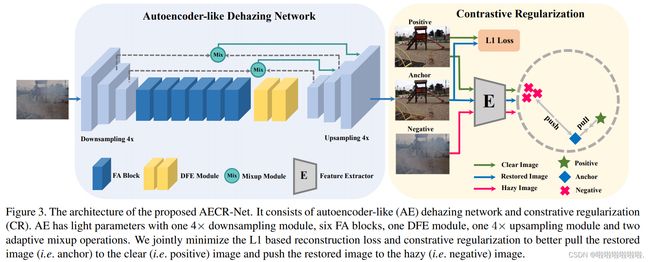【无标题】
AECRNET.py
import torch
import torch.nn as nn
import torch.nn.functional as F
from torch.nn import init
import functools
from deconv import FastDeconv
from DCNv2.dcn_v2 import DCN
# 默认卷积,不改变维度大小,仅仅是为了提取特征
def default_conv(in_channels, out_channels, kernel_size, bias=True):
return nn.Conv2d(in_channels, out_channels, kernel_size, padding=(kernel_size // 2), bias=bias)
class PALayer(nn.Module):
def __init__(self, channel):
super(PALayer, self).__init__()
self.pa = nn.Sequential(
nn.Conv2d(channel, channel // 8, 1, padding=0, bias=True),
nn.ReLU(inplace=True),
nn.Conv2d(channel // 8, 1, 1, padding=0, bias=True),
nn.Sigmoid()
)
def forward(self, x):
y = self.pa(x)
return x * y
class CALayer(nn.Module):
def __init__(self, channel):
super(CALayer, self).__init__()
self.avg_pool = nn.AdaptiveAvgPool2d(1)
self.ca = nn.Sequential(
nn.Conv2d(channel, channel // 8, 1, padding=0, bias=True),
nn.ReLU(inplace=True),
nn.Conv2d(channel // 8, channel, 1, padding=0, bias=True),
nn.Sigmoid()
)
def forward(self, x):
y = self.avg_pool(x)
y = self.ca(y)
return x * y
class DehazeBlock(nn.Module):
def __init__(self, conv, dim, kernel_size, ):
super(DehazeBlock, self).__init__()
self.conv1 = conv(dim, dim, kernel_size, bias=True)
self.act1 = nn.ReLU(inplace=True)
self.conv2 = conv(dim, dim, kernel_size, bias=True)
self.calayer = CALayer(dim)
self.palayer = PALayer(dim)
def forward(self, x):
res = self.act1(self.conv1(x))
res = res + x
res = self.conv2(res)
res = self.calayer(res)
res = self.palayer(res)
res += x
return res
class DCNBlock(nn.Module):
def __init__(self, in_channel, out_channel):
super(DCNBlock, self).__init__()
self.dcn = DCN(in_channel, out_channel, kernel_size=(3,3), stride=1, padding=1).cuda()
def forward(self, x):
return self.dcn(x)
# 自适应混合
class Mix(nn.Module):
def __init__(self, m=-0.80):
super(Mix, self).__init__()
w = torch.nn.Parameter(torch.FloatTensor([m]), requires_grad=True)
w = torch.nn.Parameter(w, requires_grad=True)
self.w = w
self.mix_block = nn.Sigmoid()
def forward(self, fea1, fea2):
mix_factor = self.mix_block(self.w)
out = fea1 * mix_factor.expand_as(fea1) + fea2 * (1 - mix_factor.expand_as(fea2))
return out
class Dehaze(nn.Module):
def __init__(self, input_nc, output_nc, ngf=64, use_dropout=False, padding_type='reflect'):
super(Dehaze, self).__init__()
###### downsample
self.down1 = nn.Sequential(nn.ReflectionPad2d(3),
nn.Conv2d(input_nc, ngf, kernel_size=7, padding=0),
nn.ReLU(True))
self.down2 = nn.Sequential(nn.Conv2d(ngf, ngf*2, kernel_size=3, stride=2, padding=1),
nn.ReLU(True))
self.down3 = nn.Sequential(nn.Conv2d(ngf*2, ngf*4, kernel_size=3, stride=2, padding=1),
nn.ReLU(True))
###### FFA blocks
self.block = DehazeBlock(default_conv, ngf * 4, 3)
###### upsample
self.up1 = nn.Sequential(nn.ConvTranspose2d(ngf*4, ngf*2, kernel_size=3, stride=2, padding=1, output_padding=1),
nn.ReLU(True))
self.up2 = nn.Sequential(nn.ConvTranspose2d(ngf*2, ngf, kernel_size=3, stride=2, padding=1, output_padding=1),
nn.ReLU(True))
self.up3 = nn.Sequential(nn.ReflectionPad2d(3),
nn.Conv2d(ngf, output_nc, kernel_size=7, padding=0),
nn.Tanh())
self.dcn_block = DCNBlock(256, 256)
self.deconv = FastDeconv(3, 3, kernel_size=3, stride=1, padding=1)
self.mix1 = Mix(m=-1)
self.mix2 = Mix(m=-0.6)
def forward(self, input):
x_deconv = self.deconv(input) # preprocess
x_down1 = self.down1(x_deconv) # [bs, 64, 256, 256]
x_down2 = self.down2(x_down1) # [bs, 128, 128, 128]
x_down3 = self.down3(x_down2) # [bs, 256, 64, 64]
x1 = self.block(x_down3)
x2 = self.block(x1)
x3 = self.block(x2)
x4 = self.block(x3)
x5 = self.block(x4)
x6 = self.block(x5)
x_dcn1 = self.dcn_block(x6)
x_dcn2 = self.dcn_block(x_dcn1)
x_out_mix = self.mix1(x_down3, x_dcn2)
x_up1 = self.up1(x_out_mix) # [bs, 128, 128, 128]
x_up1_mix = self.mix2(x_down2, x_up1)
x_up2 = self.up2(x_up1_mix) # [bs, 64, 256, 256]
out = self.up3(x_up2) # [bs, 3, 256, 256]
return out
CR.py
import torch.nn as nn
import torch
from torch.nn import functional as F
import torch.nn.functional as fnn
from torch.autograd import Variable
import numpy as np
from torchvision import models
class Vgg19(torch.nn.Module):
def __init__(self, requires_grad=False):
super(Vgg19, self).__init__()
vgg_pretrained_features = models.vgg19(pretrained=True).features
self.slice1 = torch.nn.Sequential()
self.slice2 = torch.nn.Sequential()
self.slice3 = torch.nn.Sequential()
self.slice4 = torch.nn.Sequential()
self.slice5 = torch.nn.Sequential()
for x in range(2):
self.slice1.add_module(str(x), vgg_pretrained_features[x])
for x in range(2, 7):
self.slice2.add_module(str(x), vgg_pretrained_features[x])
for x in range(7, 12):
self.slice3.add_module(str(x), vgg_pretrained_features[x])
for x in range(12, 21):
self.slice4.add_module(str(x), vgg_pretrained_features[x])
for x in range(21, 30):
self.slice5.add_module(str(x), vgg_pretrained_features[x])
if not requires_grad:
for param in self.parameters():
param.requires_grad = False
def forward(self, X):
h_relu1 = self.slice1(X)
h_relu2 = self.slice2(h_relu1)
h_relu3 = self.slice3(h_relu2)
h_relu4 = self.slice4(h_relu3)
h_relu5 = self.slice5(h_relu4)
return [h_relu1, h_relu2, h_relu3, h_relu4, h_relu5]
class ContrastLoss(nn.Module):
def __init__(self, ablation=False):
super(ContrastLoss, self).__init__()
self.vgg = Vgg19().cuda()
self.l1 = nn.L1Loss()
self.weights = [1.0/32, 1.0/16, 1.0/8, 1.0/4, 1.0]
self.ab = ablation
def forward(self, a, p, n):
a_vgg, p_vgg, n_vgg = self.vgg(a), self.vgg(p), self.vgg(n)
loss = 0
d_ap, d_an = 0, 0
for i in range(len(a_vgg)):
d_ap = self.l1(a_vgg[i], p_vgg[i].detach())
if not self.ab:
d_an = self.l1(a_vgg[i], n_vgg[i].detach())
contrastive = d_ap / (d_an + 1e-7)
else:
contrastive = d_ap
loss += self.weights[i] * contrastive
return loss
